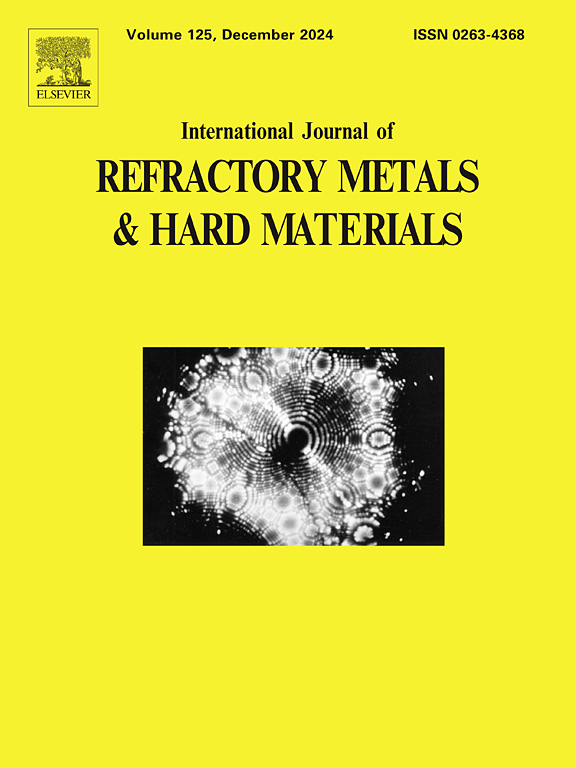Comparison of friction stir processing and heat treatment on arc erosion resistance of cold-sprayed Cu-Ti3SiC2 composite
IF 4.2
2区 材料科学
Q2 MATERIALS SCIENCE, MULTIDISCIPLINARY
International Journal of Refractory Metals & Hard Materials
Pub Date : 2025-07-14
DOI:10.1016/j.ijrmhm.2025.107332
引用次数: 0
Abstract
For Cu-based composites, the electrical conductivities, hardness and the size and distribution of the reinforcing phase have significant influence on the arc erosion resistance. Ti3SiC2 combine the excellent properties of both metals and ceramics and are ideal reinforcing phases for electrical contact materials. Friction stir processing (FSP), as a post-treatment technique, can effectively address the inherent shortcomings of cold-sprayed materials. FSP and heat treatment (HT) were used to change the microstructure and physical properties of Cu-xTi3SiC2 (x = 10, 20 wt%) composites, and its arc erosion resistance were tested at AC 220 V/20 A. The results show that Cu-20Ti3SiC2 composite has higher electrical conductivity (80.9 %IACS) and uniform ultrafine structure after FSP, so that it has the lowest surface roughness, contact resistance (20 mΩ) and ratio of arc energy to arc duration time (283 mJ/ms). The erosion surface appeared molten copper, craters, cracks, droplet splashing and pores, and Ti3SiC2 particles absorbed arc energy and were decomposed into TiO2 and SiO2.
搅拌摩擦处理与热处理对冷喷涂Cu-Ti3SiC2复合材料抗电弧侵蚀性能的影响
对于cu基复合材料,电导率、硬度、增强相的尺寸和分布对其抗电弧侵蚀性能有显著影响。Ti3SiC2结合了金属和陶瓷的优异性能,是理想的电接触材料增强相。搅拌摩擦处理(FSP)作为一种后处理技术,可以有效地解决冷喷涂材料固有的缺点。采用FSP和热处理(HT)改变Cu-xTi3SiC2 (x = 10, 20 wt%)复合材料的组织和物理性能,并在交流220 V/20 A下测试其耐电弧侵蚀性能。结果表明:Cu-20Ti3SiC2复合材料具有较高的电导率(80.9% IACS)和均匀的超细结构,具有最低的表面粗糙度、接触电阻(20 mΩ)和电弧能量/电弧持续时间比(283 mJ/ms)。侵蚀表面出现熔铜、坑、裂纹、飞溅液滴和孔洞,Ti3SiC2颗粒吸收电弧能量,分解为TiO2和SiO2。
本文章由计算机程序翻译,如有差异,请以英文原文为准。
求助全文
约1分钟内获得全文
求助全文
来源期刊
CiteScore
7.00
自引率
13.90%
发文量
236
审稿时长
35 days
期刊介绍:
The International Journal of Refractory Metals and Hard Materials (IJRMHM) publishes original research articles concerned with all aspects of refractory metals and hard materials. Refractory metals are defined as metals with melting points higher than 1800 °C. These are tungsten, molybdenum, chromium, tantalum, niobium, hafnium, and rhenium, as well as many compounds and alloys based thereupon. Hard materials that are included in the scope of this journal are defined as materials with hardness values higher than 1000 kg/mm2, primarily intended for applications as manufacturing tools or wear resistant components in mechanical systems. Thus they encompass carbides, nitrides and borides of metals, and related compounds. A special focus of this journal is put on the family of hardmetals, which is also known as cemented tungsten carbide, and cermets which are based on titanium carbide and carbonitrides with or without a metal binder. Ceramics and superhard materials including diamond and cubic boron nitride may also be accepted provided the subject material is presented as hard materials as defined above.

 求助内容:
求助内容: 应助结果提醒方式:
应助结果提醒方式:


